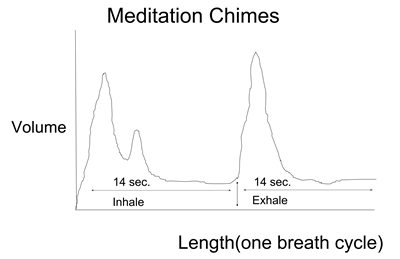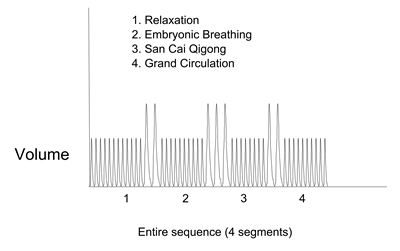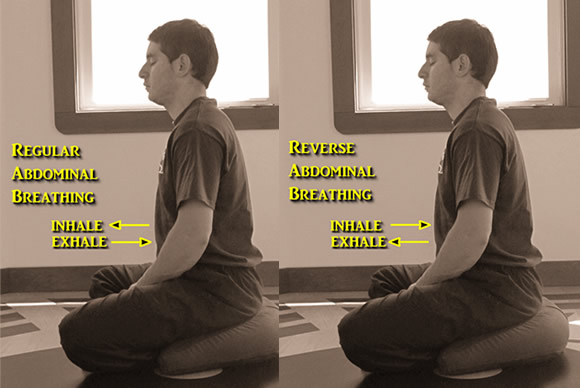with Michael Heveran.
For a disciple at the YMAA Retreat Center, every morning begins the same way. Before dawn, we quietly rise from our beds and make our way outside, filing one by one into our little gazebo, which overlooks the mountains. Each disciple grabs a mat or a cushion and faces one of two directions: Either east, toward the rising sun, or toward the center of the bagua diagram emblazoned on the floor. Clustered around our teacher, Dr. Yang Jwing-Ming, we close our eyes and begin meditation promptly at six o'clock.
Throughout the year, many guests come to the Retreat Center, excited to meditate with Dr. Yang on top of a mountain. But to these outside observers, it is not always clear what we are doing. To them, it appears that we simply sit with our eyes closed. Yet under the surface, our meditation follows a firm structure; we know exactly what we should be focusing on at any given time within the session. What follows is a guide to the theory and practice behind our meditation techniques.
Our Main Purpose
There are many types of meditation. A few characteristics are common: Meditators use the breath and mind to relax, improve concentration, open the third eye, or accomplish other goals along those same lines. For each goal exists a different technique, though those techniques often overlap or build upon one another. Our long-term goal is to find balance, not only within our own energy bodies, but also within our group of practitioners, and ultimately within nature. We have a clear and systematic method of achieving that goal, although it takes time and practice to fully feel and understand.
As we meditate, the room is silent except for two repeating chimes – one to signal when to inhale, and another to signal when to exhale. For a beginning student, these chimes should be separated by about ten seconds of silence. This means that each inhale should last about ten seconds, followed by a ten-second exhale. This will be difficult at first, but as you relax, it will become progressively easier. As we have developed greater and greater and control over our breath, we have extended this period to fourteen seconds.


Our meditation sequence lasts a total of 45 minutes (not including recovery exercises) and is separated into four segments. The first segment lasts eight minutes, the second lasts seven minutes, the third lasts 20 minutes, and the fourth lasts ten minutes. Once again, we use chimes to guide us here. Two or three chimes in quick succession indicate the end of one segment and the beginning of another.
Segment 1: Calming the Mind
The first step is to relax the body and mind. This is no easy task, and until you get used to meditation, it may require a conscious effort. Begin by sitting comfortably with the legs crossed. Other positions are also acceptable as long as your body is relaxed and you are not at risk of falling asleep. Slow down your breathing, keeping pace with the chimes, in order to guide yourself from a waking state into a semi-sleeping state. In a semi-sleeping state, the body is relaxed and the mind has very few thoughts, but the conscious self is aware and awake. You want to be on the very edge of consciousness without falling asleep.
Breathing is at the core of our meditation. There are many types of breathing, and each type is a strategy to achieve a certain goal. Over the course of a single meditation session, we will use several types of breathing for different purposes. Our first breathing strategy, normal abdominal breathing, is designed to help you relax. Breathe deeply with your abdomen, engaging the abdominal muscles to make your breath long and slender. Allow your abdomen to expand as you inhale and contract as you exhale. This type of breathing would feel ordinary, natural, and soothing; it's exactly the same way that we breathe when we're relaxed.
As you relax, you should find it progressively easier to match the pace of the chime. Your pulse should slow, and you should feel increasingly comfortable with a slow breathing pace. You should start to feel a sense of tranquility. This kind of physiological relaxation is the first step toward calming your mind, which is usually the first major obstacle for beginning students.
Conscious and Subconscious Mind
As our minds approach a semi-sleeping state, we distance ourselves from the emotional mind (xīn 心). This part of the mind is responsible for those chaotic thoughts, which are so hard to silence during meditation. It is dominated by fear, joy, love, and sorrow, feelings, which cause us to lose control over our lives. In contrast, the "wisdom mind" (yì 意), is a better representation of our true selves. Governed by logic and truth, the wisdom mind is capable of being simply present without judging every thought or observation.
In meditation, we try to allow the wisdom mind to take over in order to reach a state of neutrality. Think about the times that you have been so worked up that you said to yourself "Okay, I just need a moment. I just need to sit." This is similar to meditation when the goal is to relax the mind and the body.
We like to compare the emotional mind to a monkey, which is jumping from tree to tree in search of food. The breath is to the mind what a banana is to the monkey: as the banana calms the monkey's hunger, so too will breathing ease the restless mind. Allow each thought to pass without becoming emotionally involved. Soon, the thoughts should flow less and less until you reach a semi-sleeping state. As you become more familiar with this state, you will know what to search for and how to get there. With enough practice, it may take as little as thirty seconds to a minute to reach this point. But to begin with, just focus on trying to achieve this semi-sleeping state before the second segment begins.

Condensing Energy
Once you have achieved a semi-sleeping state, the next step is to find the energy centers and condense the energy around them. The upper energy center, also known as the upper dan tian (dān tiān 丹田), is located within the limbic system, a group of brain structures beneath the cerebral cortex. The lower center, or lower dan tian, is located within the digestive system. Each center performs a different function; the upper dan tian houses the mind and spirit while the lower dan tian preserves and stores energy. Think of the body as a machine: the lower center supplies the energy, while the upper center determines how the machine will use that energy. When these two energy centers are out of sync, the machine might act dysfunctional, causing harm to itself or others. But when the two centers are synchronized, then the machine can operate harmoniously and with purpose. When your two energy centers act in concert with one another, they are no longer two separate entities, but rather two parts of a single, smoothly operating machine.
Once you locate your two energy centers, you can begin to condense energy around either of them. This will require that you hold your attention at a central point, beginning with the upper dan tian. To understand this, imagine a vast, open field scattered with thousands of people. These people represent your thoughts. Further, each thought represents an energy particle around the upper dan tian with the potential to pull you off-center. Ordinarily, these thoughts flash in and out of your consciousness chaotically. You think to yourself: What am I getting mom for her birthday? The boss has yelled at me again for no reason. I need to add that to the grocery list. My back hurts. If you can focus your thoughts, as if finding the center of the crowd and gathering the people around you, then you can organize them and control their effects. The more that you can resist from being pulled off-center, remaining unaffected by your thoughts, the better off you will be.
You cannot rid yourself of these thoughts, but you can acknowledge them and remain unaffected. To do so, you must get their attention by finding the center of the crowd. Your message to the crowd is: "I acknowledge you and I will deal with you at the right time."
So, how do we accomplish this?
The first step is to modify our breathing. Up until now, we have been trying to relax by breathing deeply but normally. After we have achieved a semi-sleeping state, we adopt a slightly different breathing strategy. As you inhale, contract your abdomen instead of allowing it to expand. At the same time, raise your perineum by contracting your anus muscles. As you exhale, let your abdomen and perineum relax again. This technique is called reverse abdominal breathing, and is useful not just for meditating, but for generating power in martial arts as well. Continue to use reverse abdominal breathing for the rest of your meditation session. As a general rule of thumb, any time the mind is involved in directing energy, we use reverse abdominal breathing.
Once you can perform the basic breathing strategy, there are three additional techniques which can help you condense your energy:
Technique 1: Inhale longer than you exhale
Instead of inhaling for the same length of time that you exhale, try making your inhales longer. As the mind delves deeper with each inhale, focus on leading the energy inward, condensing in the upper dan tian. This is the opposite of a sigh. When you sigh, you exhale longer than you inhale, releasing energy. As you increase the relative length of your inhale, do your best to keep your breaths slender and smooth, coordinating with the chimes.
Technique 2: Hold your breath
After each inhale, try holding your breath slightly. When you hold your breath, focus on condensing your energy. As you exhale, you should allow yourself to relax, but not so much that you lose control of the energy that you condensed in the last breath. Each inhale should guide the energy further and further inward. As you become more experienced at feeling the energy, it will become easier to sustain your attention at the center. Although it takes effort to condense your energy, you should not be too aggressive. It's like making a snowball: You want to pack it tightly, but you don't want to crush it.
Technique 3: Humming
Sometimes it helps to hum at various pitches. Even before meditating, you can experiment with different pitches to find the right one to place your mind at your upper dan tian. Once you find the right tone – you may find that it is relatively high-pitched – try to hold it through a breath cycle. While inhaling, or when meditating around other people, you won't be able to physically hum, but you can achieve the same results by humming within your mind instead.
It is possible to use all three of these techniques together. To do so, hum at the proper pitch for a full breath cycle, inhaling and exhaling. Continue to hold the note while guiding the energy inward with another long, slender inhales. Once you have inhaled to about 75 per cent capacity, hold your breath while still leading the energy inward and humming in your mind, then exhale. Once again, you can visualize the energy as a crowd of people. First, you get the crowd's attention with a noise loud enough for everyone to hear (technique 3). Now they have a focal point. Next, you have them all take five steps toward that sound (technique 1). Each time they advance closer to the center, they adjust themselves and shift to stand more comfortably, and so as not to step on each other's toes (technique 2).
Keep in mind that, as a beginner, it may be very difficult to try all of these new techniques at once. Start slowly. Build slowly.
Return the Son to the Mother
The next step is to "return the son to the mother," leading energy from your upper dan tian to your lower dan tian. These two centers represent two opposing poles in the body, one yin and one yang. But they were not always separate. Every human body begins as a zygote, a single cell from which every other cell branched out. This central point is the lower dan tian. Early in the body's development , the upper dan tian splits off of the lower dan tian. This is why we sometimes refer to the upper dan tian as the "son" and the lower dan tian as the "mother." To return the son to the mother, we are taking energy from the upper dan tian and returning it to its original source in the lower dan tian.
To do so, place your mind at your upper dan tian, then, using reverse abdominal breathing, inhale and lead the energy from the upper dan tian down to the lower dan tian, the body's physical center. Exhale and relax, simply allowing the energy to settle. Once the energy has settled, reunited in the lower dan tian, focus your mind there. Reset your breath cycle so that your inhale and exhale take the same amount of time . Maintain this breathing pace and keep the mind at the lower dan tian until the next segment.
| Glossary English | Pinyin | Traditional Characters |
| Energy center | Dān tiān | 丹田 |
| Emotional mind | Xīn | 心 |
| Wisdom mind | Yì | 意 |
| Three Natural Powers Qigong | Sān cái qì gōng | 三才氣功 |

